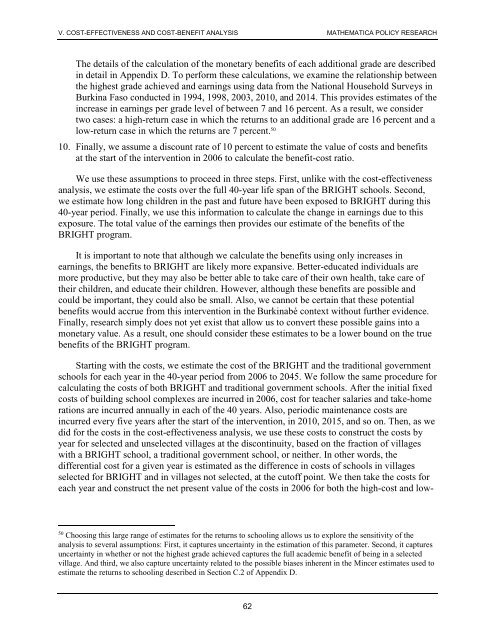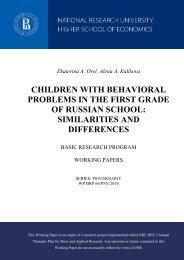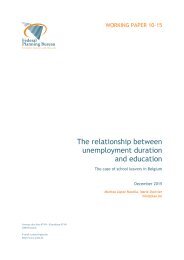Ten-Year Impacts of Burkina Faso’s BRIGHT Program
n?u=RePEc:mpr:mprres:2ecdd42bb503422b802ce20da2bf64b7&r=edu
n?u=RePEc:mpr:mprres:2ecdd42bb503422b802ce20da2bf64b7&r=edu
You also want an ePaper? Increase the reach of your titles
YUMPU automatically turns print PDFs into web optimized ePapers that Google loves.
V. COST-EFFECTIVENESS AND COST-BENEFIT ANALYSIS MATHEMATICA POLICY RESEARCH<br />
The details <strong>of</strong> the calculation <strong>of</strong> the monetary benefits <strong>of</strong> each additional grade are described<br />
in detail in Appendix D. To perform these calculations, we examine the relationship between<br />
the highest grade achieved and earnings using data from the National Household Surveys in<br />
<strong>Burkina</strong> Faso conducted in 1994, 1998, 2003, 2010, and 2014. This provides estimates <strong>of</strong> the<br />
increase in earnings per grade level <strong>of</strong> between 7 and 16 percent. As a result, we consider<br />
two cases: a high-return case in which the returns to an additional grade are 16 percent and a<br />
low-return case in which the returns are 7 percent. 50<br />
10. Finally, we assume a discount rate <strong>of</strong> 10 percent to estimate the value <strong>of</strong> costs and benefits<br />
at the start <strong>of</strong> the intervention in 2006 to calculate the benefit-cost ratio.<br />
We use these assumptions to proceed in three steps. First, unlike with the cost-effectiveness<br />
analysis, we estimate the costs over the full 40-year life span <strong>of</strong> the <strong>BRIGHT</strong> schools. Second,<br />
we estimate how long children in the past and future have been exposed to <strong>BRIGHT</strong> during this<br />
40-year period. Finally, we use this information to calculate the change in earnings due to this<br />
exposure. The total value <strong>of</strong> the earnings then provides our estimate <strong>of</strong> the benefits <strong>of</strong> the<br />
<strong>BRIGHT</strong> program.<br />
It is important to note that although we calculate the benefits using only increases in<br />
earnings, the benefits to <strong>BRIGHT</strong> are likely more expansive. Better-educated individuals are<br />
more productive, but they may also be better able to take care <strong>of</strong> their own health, take care <strong>of</strong><br />
their children, and educate their children. However, although these benefits are possible and<br />
could be important, they could also be small. Also, we cannot be certain that these potential<br />
benefits would accrue from this intervention in the <strong>Burkina</strong>bé context without further evidence.<br />
Finally, research simply does not yet exist that allow us to convert these possible gains into a<br />
monetary value. As a result, one should consider these estimates to be a lower bound on the true<br />
benefits <strong>of</strong> the <strong>BRIGHT</strong> program.<br />
Starting with the costs, we estimate the cost <strong>of</strong> the <strong>BRIGHT</strong> and the traditional government<br />
schools for each year in the 40-year period from 2006 to 2045. We follow the same procedure for<br />
calculating the costs <strong>of</strong> both <strong>BRIGHT</strong> and traditional government schools. After the initial fixed<br />
costs <strong>of</strong> building school complexes are incurred in 2006, cost for teacher salaries and take-home<br />
rations are incurred annually in each <strong>of</strong> the 40 years. Also, periodic maintenance costs are<br />
incurred every five years after the start <strong>of</strong> the intervention, in 2010, 2015, and so on. Then, as we<br />
did for the costs in the cost-effectiveness analysis, we use these costs to construct the costs by<br />
year for selected and unselected villages at the discontinuity, based on the fraction <strong>of</strong> villages<br />
with a <strong>BRIGHT</strong> school, a traditional government school, or neither. In other words, the<br />
differential cost for a given year is estimated as the difference in costs <strong>of</strong> schools in villages<br />
selected for <strong>BRIGHT</strong> and in villages not selected, at the cut<strong>of</strong>f point. We then take the costs for<br />
each year and construct the net present value <strong>of</strong> the costs in 2006 for both the high-cost and low-<br />
50<br />
Choosing this large range <strong>of</strong> estimates for the returns to schooling allows us to explore the sensitivity <strong>of</strong> the<br />
analysis to several assumptions: First, it captures uncertainty in the estimation <strong>of</strong> this parameter. Second, it captures<br />
uncertainty in whether or not the highest grade achieved captures the full academic benefit <strong>of</strong> being in a selected<br />
village. And third, we also capture uncertainty related to the possible biases inherent in the Mincer estimates used to<br />
estimate the returns to schooling described in Section C.2 <strong>of</strong> Appendix D.<br />
62







